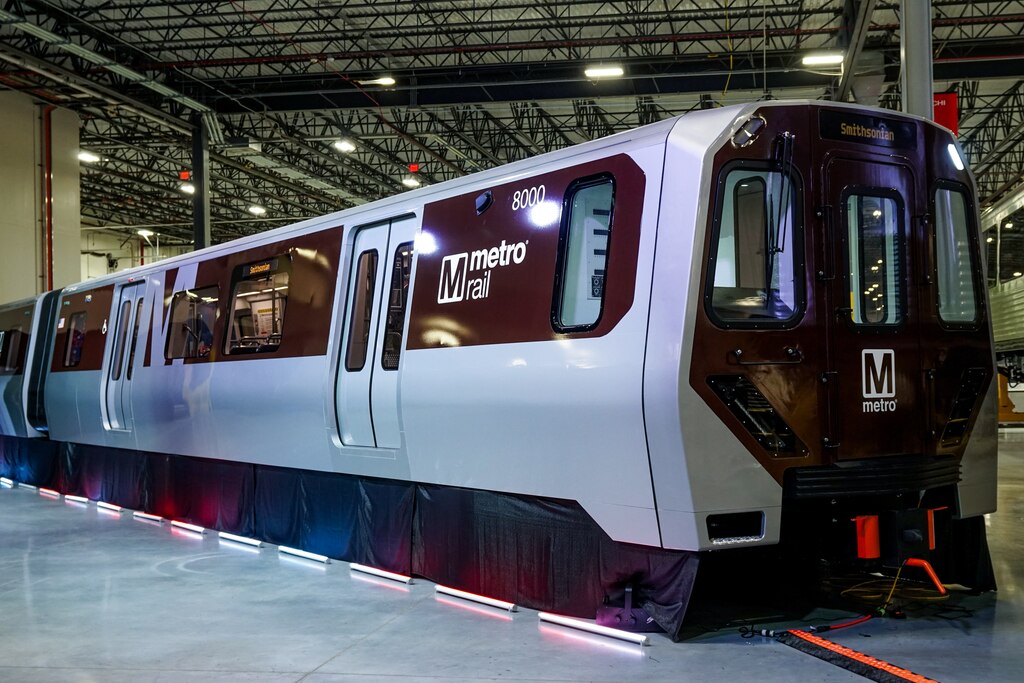The path to brand new subway trains arriving soon under Baltimore City streets goes through Hagerstown.
State officials and company executives from Japanese technology and infrastructure giant Hitachi celebrated the official opening of a new 307,000-square-foot manufacturing plant Monday that will supply trains for public transit agencies in Baltimore, Washington, D.C., and beyond.
The massive facility, located just outside the Western Maryland town, can assemble as many as 20 rail cars per month, company executives said, with the help of cutting-edge factory technologies like artificial intelligence and even robot “dogs.”
“This factory is not merely a production center, it is a symbol of Hitachi’s vision concretely applied,” Hitachi Executive Chairman Toshiaki Higashihara said.
The $100 million facility, which will employ as many as 500 by 2027, will provide trains to agencies all over North America, including Philadelphia and Toronto. It is carbon-neutral, getting 70% of its power from its own solar panels.
It’s an example of “Maryland and Japan moving on the same track,” said Lt. Gov. Aruna Miller, who highlighted Gov. Wes Moore’s recent trip to Japan.

Shigeo Yamada, the Japanese ambassador to the United States, used the same metaphor, saying the facility demonstrated “the enduring depth of the economic relationship between our two countries.”
Recovering from a bout with COVID-19, U.S. Sen. Chris Van Hollen said in a pre-recorded statement: “When we build in America, Americans win.”
Van Hollen also expressed support for investing in job training and apprenticeship programs to provide workers with the necessary skills to work there.
“We are here in Maryland because we find a strong industrial ecosystem and a strong supply chain that aligns with our mission,” said Giuseppe Marino, CEO of Hitachi’s rail division.
Monday’s ribbon-cutting event, which felt like something between a corporate Ted Talk and a megachurch sermon on the holiness of rail transit, spared no expense. Hitachi brought a light show, music and smoke machine onto the factory floor. Black curtains dropped alongside virtual confetti to reveal future Baltimore subway cars lined up in a variety of stages of completion.
The future Baltimore subway trains are essentially metal shells when they arrive from Japan. They get placed onto autonomous vehicles that move them to seven different stations around the facility, including one where the train shells are attached to their rail wheels.

Workers scan train components with handheld lasers to check for part compatibility, as well as any flaws. The robot “dogs” — yes, they can perform tricks like “wagging” and jumping — scan the rail cars on their own, including overnight when workers aren’t present, for assembly quality control.
Cameras and sensors all over the factory floor monitor for workplace safety. When a worker gets too close to a moving factory vehicle, for example, alarms beep and lights flash on the vehicle. When a worker walks within a certain distance of an active crane, a similar alarm sounds, and a voice over a loudspeaker tells them to back up.
There’s a rail track behind the facility, measuring roughly eight football fields in length, where the train cars undergo initial testing.
The facility has already sent six of 78 new Metro subway cars to Baltimore, where the Maryland Transit Administration has been periodically closing the line on weekends to conduct testing. The rail cars will also use a new train control system.
“The trains are in good shape, the signaling system is in good shape, you have to just make sure they talk to each other,” said MTA Administrator Holly Arnold, standing next to a nearly finished subway train Monday. “The integration testing is what’s been happening, just making sure the different computers are aligned.”

The first of the new rail cars will go into service before year’s end, Arnold said. Funds are allocated for additional rehabilitation of the subway line, including of station elevators and escalators, in the state’s capital budget, she added.
The Baltimore subway, depending on who you ask, is either Baltimore’s best-kept secret or a sad reminder of what could have been.
The single heavy-rail line, stretching from Owings Mills to Johns Hopkins Hospital, opened in the early 1980s to great fanfare and with the intention of being expanded into a wider system of multiple lines like the Metro in Washington, D.C. But Baltimore was a few years too late to take advantage of a federal funding wave for public transit.
When it opened, the line was busy — northwest Baltimore County residents who worked downtown flocked to it as a commuting option, and city residents hopped on to cut across town for appointments at Johns Hopkins or for lunch at Lexington Market. Even today — when the subway is running properly — there’s no quicker way across town.
But ridership has fallen off over the years and, like many other transit lines, it took a nosedive during the pandemic. It has rebounded somewhat since, but is trending down so far this year, according to agency figures.




Comments
Welcome to The Banner's subscriber-only commenting community. Please review our community guidelines.